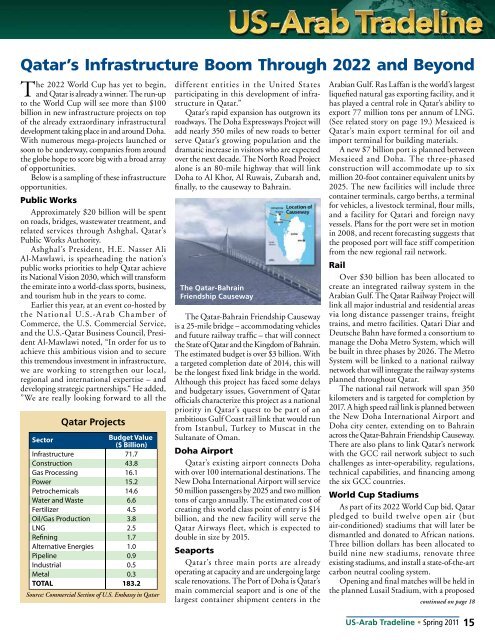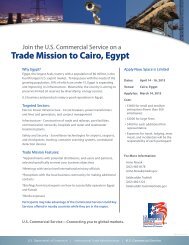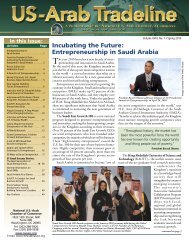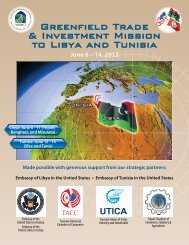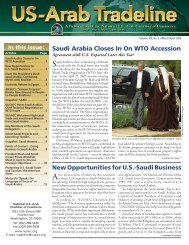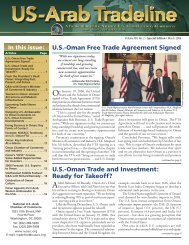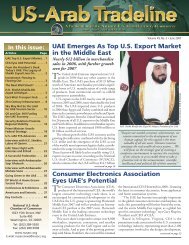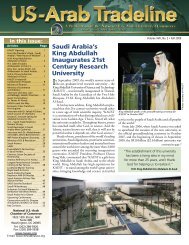Qatar - National US-Arab Chamber of Commerce
Qatar - National US-Arab Chamber of Commerce
Qatar - National US-Arab Chamber of Commerce
Create successful ePaper yourself
Turn your PDF publications into a flip-book with our unique Google optimized e-Paper software.
<strong>Qatar</strong>’s Infrastructure Boom Through 2022 and Beyond<br />
The 2022 World Cup has yet to begin,<br />
and <strong>Qatar</strong> is already a winner. The run-up<br />
to the World Cup will see more than $100<br />
billion in new infrastructure projects on top<br />
<strong>of</strong> the already extraordinary infrastructural<br />
development taking place in and around Doha.<br />
With numerous mega-projects launched or<br />
soon to be underway, companies from around<br />
the globe hope to score big with a broad array<br />
<strong>of</strong> opportunities.<br />
Below is a sampling <strong>of</strong> these infrastructure<br />
opportunities.<br />
Public Works<br />
Approximately $20 billion will be spent<br />
on roads, bridges, wastewater treatment, and<br />
related services through Ashghal, <strong>Qatar</strong>’s<br />
Public Works Authority.<br />
Ashghal’s President, H.E. Nasser Ali<br />
Al-Mawlawi, is spearheading the nation’s<br />
public works priorities to help <strong>Qatar</strong> achieve<br />
its <strong>National</strong> Vision 2030, which will transform<br />
the emirate into a world-class sports, business,<br />
and tourism hub in the years to come.<br />
Earlier this year, at an event co-hosted by<br />
the <strong>National</strong> U.S.-A rab <strong>Chamber</strong> <strong>of</strong><br />
<strong>Commerce</strong>, the U.S. Commercial Service,<br />
and the U.S.-<strong>Qatar</strong> Business Council, President<br />
Al-Mawlawi noted, “In order for us to<br />
achieve this ambitious vision and to secure<br />
this tremendous investment in infrastructure,<br />
we are working to strengthen our local,<br />
regional and international expertise – and<br />
developing strategic partnerships.“ He added,<br />
”We are really looking forward to all the<br />
<strong>Qatar</strong> Projects<br />
Source: Commercial Section <strong>of</strong> U.S. Embassy in <strong>Qatar</strong><br />
different entities in the United States<br />
participating in this development <strong>of</strong> infrastructure<br />
in <strong>Qatar</strong>.”<br />
<strong>Qatar</strong>’s rapid expansion has outgrown its<br />
roadways. The Doha Expressways Project will<br />
add nearly 350 miles <strong>of</strong> new roads to better<br />
serve <strong>Qatar</strong>’s growing population and the<br />
dramatic increase in visitors who are expected<br />
over the next decade. The North Road Project<br />
alone is an 80-mile highway that will link<br />
Doha to Al Khor, Al Ruwais, Zubarah and,<br />
finally, to the causeway to Bahrain.<br />
The <strong>Qatar</strong>-Bahrain<br />
Friendship Causeway<br />
The <strong>Qatar</strong>-Bahrain Friendship Causeway<br />
is a 25-mile bridge – accommodating vehicles<br />
and future railway traffic – that will connect<br />
the State <strong>of</strong> <strong>Qatar</strong> and the Kingdom <strong>of</strong> Bahrain.<br />
The estimated budget is over $3 billion. With<br />
a targeted completion date <strong>of</strong> 2014, this will<br />
be the longest fixed link bridge in the world.<br />
Although this project has faced some delays<br />
and budgetary issues, Government <strong>of</strong> <strong>Qatar</strong><br />
<strong>of</strong>ficials characterize this project as a national<br />
priority in <strong>Qatar</strong>’s quest to be part <strong>of</strong> an<br />
ambitious Gulf Coast rail link that would run<br />
from Istanbul, Turkey to Muscat in the<br />
Sultanate <strong>of</strong> Oman.<br />
Doha Airport<br />
<strong>Qatar</strong>’s existing airport connects Doha<br />
with over 100 international destinations. The<br />
New Doha International Airport will service<br />
50 million passengers by 2025 and two million<br />
tons <strong>of</strong> cargo annually. The estimated cost <strong>of</strong><br />
creating this world class point <strong>of</strong> entry is $14<br />
billion, and the new facility will serve the<br />
<strong>Qatar</strong> Airways fleet, which is expected to<br />
double in size by 2015.<br />
Seaports<br />
<strong>Qatar</strong>’s three main ports are already<br />
operating at capacity and are undergoing large<br />
scale renovations. The Port <strong>of</strong> Doha is <strong>Qatar</strong>’s<br />
main commercial seaport and is one <strong>of</strong> the<br />
largest container shipment centers in the<br />
<strong>Arab</strong>ian Gulf. Ras Laffan is the world’s largest<br />
liquefied natural gas exporting facility, and it<br />
has played a central role in <strong>Qatar</strong>’s ability to<br />
export 77 million tons per annum <strong>of</strong> LNG.<br />
(See related story on page 19.) Mesaieed is<br />
<strong>Qatar</strong>’s main export terminal for oil and<br />
import terminal for building materials.<br />
A new $7 billion port is planned between<br />
Mesaieed and Doha. The three-phased<br />
construction will accommodate up to six<br />
million 20-foot container equivalent units by<br />
2025. The new facilities will include three<br />
container terminals, cargo berths, a terminal<br />
for vehicles, a livestock terminal, flour mills,<br />
and a facility for <strong>Qatar</strong>i and foreign navy<br />
vessels. Plans for the port were set in motion<br />
in 2008, and recent forecasting suggests that<br />
the proposed port will face stiff competition<br />
from the new regional rail network.<br />
Rail<br />
Over $30 billion has been allocated to<br />
create an integrated railway system in the<br />
<strong>Arab</strong>ian Gulf. The <strong>Qatar</strong> Railway Project will<br />
link all major industrial and residential areas<br />
via long distance passenger trains, freight<br />
trains, and metro facilities. <strong>Qatar</strong>i Diar and<br />
Deutsche Bahn have formed a consortium to<br />
manage the Doha Metro System, which will<br />
be built in three phases by 2026. The Metro<br />
System will be linked to a national railway<br />
network that will integrate the railway systems<br />
planned throughout <strong>Qatar</strong>.<br />
The national rail network will span 350<br />
kilometers and is targeted for completion by<br />
2017. A high speed rail link is planned between<br />
the New Doha International Airport and<br />
Doha city center, extending on to Bahrain<br />
across the <strong>Qatar</strong>-Bahrain Friendship Causeway.<br />
There are also plans to link <strong>Qatar</strong>’s network<br />
with the GCC rail network subject to such<br />
challenges as inter-operability, regulations,<br />
technical capabilities, and financing among<br />
the six GCC countries.<br />
World Cup Stadiums<br />
As part <strong>of</strong> its 2022 World Cup bid, <strong>Qatar</strong><br />
pledged to build twelve open air (but<br />
air-conditioned) stadiums that will later be<br />
dismantled and donated to African nations.<br />
Three billion dollars has been allocated to<br />
build nine new stadiums, renovate three<br />
existing stadiums, and install a state-<strong>of</strong>-the-art<br />
carbon neutral cooling system.<br />
Opening and final matches will be held in<br />
the planned Lusail Stadium, with a proposed<br />
continued on page 18<br />
<strong>US</strong>-<strong>Arab</strong> Tradeline • Spring 2011 15


